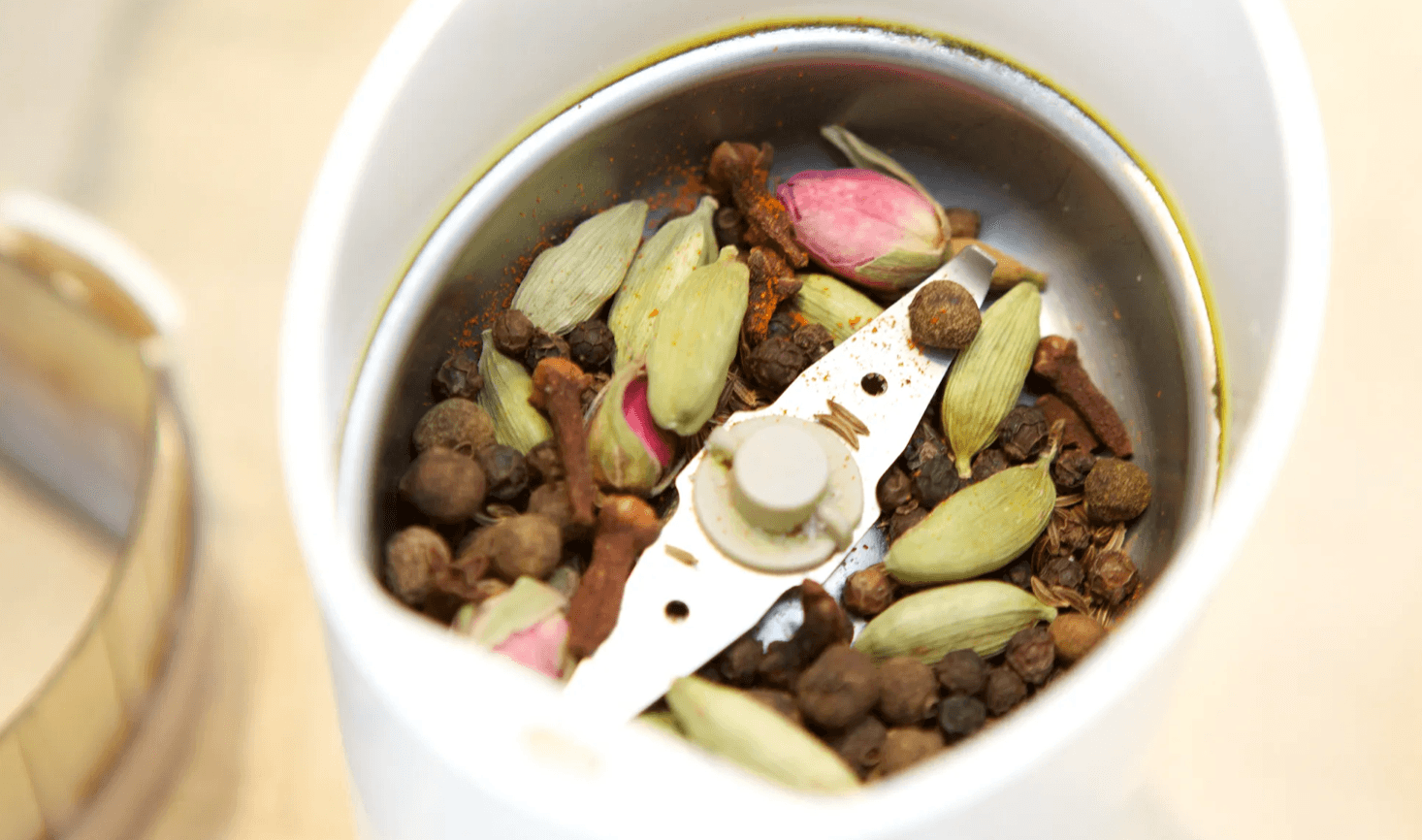Can you use a coffee grinder for spices? The answer is yes, you can, but there are crucial things to consider. Using your coffee grinder for spices can impart unwanted flavors and aromas, and it’s important to know how to minimize these effects. This article dives deep into the world of using your coffee grinder for spice grinding, covering the potential risks, offering helpful cleaning methods, and exploring the best practices to follow. Let’s explore how to use your coffee grinder for spices effectively.

Image Source: www.coffeehit.co.uk
The Allure of Using a Coffee Grinder for Spices
Why would you want to use a coffee grinder for spices? There are several compelling reasons:
- Convenience: Most kitchens already have a coffee grinder, eliminating the need to purchase another appliance.
- Cost-effectiveness: A dedicated spice grinder is an added expense. Using your existing coffee grinder saves money.
- Versatility: Coffee grinders can handle a variety of spices, from peppercorns to cinnamon sticks.
- Space-saving: In small kitchens, minimizing appliances is essential.
- Urgency: you need spices right away and you don’t have a dedicated spice grinder, a coffee grinder can be a lifesaver.
Spice Grinder vs. Coffee Grinder: What’s the Difference?
While they look similar and operate on the same principle, there are crucial differences between a spice grinder and a coffee grinder:
| Feature | Coffee Grinder | Spice Grinder |
|---|---|---|
| Purpose | Grinding coffee beans for brewing. | Grinding whole spices for culinary use. |
| Design | Often burr grinders for consistent size. | Blade grinders are more common. |
| Flavor Impact | Designed to minimize flavor retention. | Flavor retention is less of a concern. |
| Cleaning | Requires regular cleaning to remove oils. | Requires cleaning to prevent flavor mixing. |
| Versatility | Less suitable for oily or pungent spices. | Designed to handle a wider range of spices. |
The main difference lies in how the grinder is used and the residue it retains. Coffee beans have a distinct flavor profile. Spices have extremely pungent oils.
The Coffee Grinder Contamination Risk: A Serious Consideration
The biggest risk of using a coffee grinder for spices is coffee grinder contamination risk, meaning the lingering flavors and aromas that can transfer between coffee and spices. This can result in:
- Coffee that tastes like spices: Nobody wants a morning cup of coffee with a hint of cumin or coriander.
- Spices that taste like coffee: This can ruin the flavor of your dishes, particularly in delicate recipes.
- A lingering, unpleasant aroma: The combined smell of coffee and spices can be overpowering and unappetizing.
Best Spices to Grind in Coffee Grinder: Minimizing Flavor Transfer
Some spices are less likely to cause lasting contamination than others. Here’s a breakdown of the best spices to grind in coffee grinder to minimize the risk:
- Good Choices:
- Peppercorns: Their strong flavor is relatively compatible with coffee.
- Coriander Seeds: Relatively neutral flavor.
- Cumin Seeds: Strong, but less oily than some other spices.
- Dried Chili Flakes: Use caution, as they can be very potent.
- Spices to Avoid (or Use a Dedicated Grinder):
- Cinnamon: Very potent and likely to leave a strong flavor.
- Nutmeg: Similar to cinnamon.
- Cloves: Extremely strong and oily.
- Turmeric: Stains easily and has a potent flavor.
- Star Anise: Very strong, licorice flavor.
- Oily Seeds (Flax, Sesame): Can clog the grinder and leave a greasy residue.
- Caution Advised:
- Using Coffee Grinder for Herbs: Dried herbs like rosemary, thyme, and oregano can be ground in a coffee grinder, but be mindful of their strong aromas, which can transfer to your coffee. Start with small quantities and clean thoroughly.
Consider dedicating your coffee grinder to certain classes of flavors if you plan on using it for both. For example, use it to grind black pepper, chili flakes, and coriander seeds, but never to grind cinnamon, cloves, or nutmeg.
Effective Cleaning Methods: Cleaning Coffee Grinder After Spices
Thorough cleaning is essential after grinding spices in your coffee grinder. Here are several methods for cleaning coffee grinder after spices:
- The Rice Method:
- Grind 1/4 cup of uncooked white rice into a fine powder. The rice absorbs residual oils and flavors.
- Discard the rice powder.
- Wipe down the grinder’s interior with a dry cloth.
- Repeat if necessary.
- This is a good starting point for removing residual spice oils and flavors.
- The Baking Soda Method:
- Mix 1 tablespoon of baking soda with 2 tablespoons of water to form a paste.
- Apply the paste to the interior of the grinder.
- Let it sit for 30 minutes to absorb odors.
- Wipe clean with a damp cloth.
- Grind a small amount of rice to remove any remaining baking soda.
- Baking soda is excellent for odor removal and helps to neutralize spice smells.
- The Vinegar Method:
- Dampen a cloth with white vinegar.
- Wipe down the interior of the grinder.
- Allow the vinegar to air dry.
- Grind a small amount of rice to remove any remaining vinegar smell.
- Vinegar is a natural disinfectant and effective at cutting through oils.
- Disassembling and Cleaning:
- If your grinder allows, disassemble it as much as possible.
- Wash removable parts with warm, soapy water.
- Dry thoroughly before reassembling.
- This provides the most thorough cleaning, but be careful to follow the manufacturer’s instructions for disassembly.
- Commercial Grinder Cleaners:
- There are several commercial grinder cleaners available.
- Follow the manufacturer’s instructions carefully.
- These are often designed for coffee grinders but can be adapted for spices.
Important Note: Always unplug your coffee grinder before cleaning. Never immerse the motor base in water.
Coffee Grinder Spice Grinding: Best Practices
To minimize flavor transfer and ensure the best results when coffee grinder spice grinding, follow these best practices:
- Use a Dedicated Grinder (If Possible): The best solution is always to have a dedicated spice grinder to avoid any cross-contamination.
- Choose the Right Grinder Type: Blade grinders are generally better suited for spices, as they create a coarser grind. Burr grinders are designed for more consistent coffee grinds.
- Grind Small Batches: Only grind the amount of spice you need for immediate use.
- Clean Immediately After Use: Don’t let spice residue linger in the grinder.
- Consider Designating Your Grinder: If you plan to use your coffee grinder for spices regularly, consider designating it solely for that purpose.
- Be Mindful of Oily Spices: Oily spices like flax seeds and sesame seeds can clog the grinder. Grind them sparingly, if at all.
- Use a Coarse Grind: Spices generally benefit from a coarser grind. Avoid grinding them into a fine powder unless the recipe specifically calls for it.
- Pulse Grind: Use short bursts of grinding to avoid overheating the spices and releasing too much oil.
- Monitor the Smell: Pay attention to any lingering smells after cleaning, and repeat the cleaning process if needed.
- Inspect for Residue: Check the grinder for any visible residue after cleaning, and address it with a targeted cleaning method.
Exploring Spice Grinder Alternative: Other Options
If you’re hesitant to use your coffee grinder for spices, several spice grinder alternative methods exist:
- Mortar and Pestle: A classic tool for grinding spices by hand. It provides excellent control over the grind size and releases the spices’ aroma and flavors beautifully.
- Manual Spice Grinder (Alternative to Spice Mill): A small, hand-cranked grinder specifically designed for spices.
- Food Processor: Can be used to grind larger quantities of spices, but it’s more difficult to clean.
- Knife and Cutting Board: For coarsely chopping spices, especially herbs.
- Pre-Ground Spices: Buying pre-ground spices is the easiest option, but they lose their flavor more quickly than freshly ground spices.
Here’s a comparison table for various alternatives to spice mill:
| Method | Pros | Cons | Best For |
|---|---|---|---|
| Mortar and Pestle | Excellent control, enhances flavor, no cross-contamination. | Labor-intensive, time-consuming, smaller batches. | Small quantities, delicate spices, flavorful grinding. |
| Manual Spice Grinder | Convenient, dedicated use, portable. | Limited capacity, can be inconsistent, requires manual effort. | Small to medium quantities, travel. |
| Food Processor | Large quantities, fast. | Difficult to clean, less control over grind size. | Large batches, coarse grinding. |
| Knife and Board | Simple, accessible. | Uneven chop, not ideal for grinding. | Coarsely chopped herbs, prepping spices for cooking. |
| Pre-Ground Spices | Convenient, readily available. | Loses flavor quickly, less aroma, potential for additives. | Quick cooking, convenience, when fresh grinding is not needed. |
| Grinding whole spices is always preferable for the freshest flavors. |
Dedicated Spice Grinder: The Ideal Solution
The ideal solution for anyone who frequently uses spices is to invest in a dedicated spice grinder. A dedicated spice grinder eliminates the risk of flavor transfer and ensures that your coffee and spices retain their individual flavors. These grinders are often inexpensive and can significantly improve your culinary experience.
Grasping Blade vs Burr Grinders for Spice
For spices, a blade grinder is often sufficient. The goal is to break down the grinding whole spices to release flavor, and the chopping action of blades is well-suited for this. Burr grinders, while offering consistency, are more expensive and not necessary for most spice applications.
F.A.Q Section
Q: Can I grind coffee beans in a spice grinder?
A: While you can, it’s not recommended. The spice grinder won’t provide the consistent grind size needed for optimal coffee extraction. Furthermore, spices may leave behind flavors that will affect your coffee.
Q: What is the best way to clean a coffee grinder after grinding spices?
A: The rice method is a good starting point. Grind ¼ cup of uncooked white rice, then wipe down the interior. Follow up with the baking soda or vinegar method if needed.
Q: Is it safe to grind hard spices like star anise in a coffee grinder?
A: Yes, but do so with caution. Hard spices can put extra strain on the grinder’s motor and blades. Pulse grind to avoid overheating. Cleaning afterward is very important to avoid flavour contamination.
Q: Can I use a coffee grinder to grind nuts?
A: Yes, but nuts are oily and can leave a residue. Grind them in small batches and clean the grinder thoroughly afterward.
Q: How do I prevent my coffee from tasting like spices?
A: The best way is to use a dedicated spice grinder. If you must use your coffee grinder for spices, choose less potent spices, grind in small batches, and clean thoroughly after each use.
Q: What is a good spice grinder alternative if I don’t want to use my coffee grinder?
A: A mortar and pestle or a manual spice grinder are excellent alternatives.
Q: Can I use a wet cloth to wipe the inside of my coffee grinder?
A: Avoid getting the motor wet. Dampen a cloth and wring out excess water before wiping the interior.
By carefully considering the risks and following these best practices, you can safely use your coffee grinder for spices while minimizing the risk of flavor transfer.

Hi, I’m Larry Fish, the mind behind MyGrinderGuide.com.. With a passion for all things kitchen appliances, I created this blog to share my hands-on experience and expert knowledge. Whether it’s helping you choose the right tools for your culinary adventures or offering tips to make your kitchen more efficient, I’m here to guide you. My goal is to make your time in the kitchen not only easier but also enjoyable! Welcome to my world of kitchen mastery!
